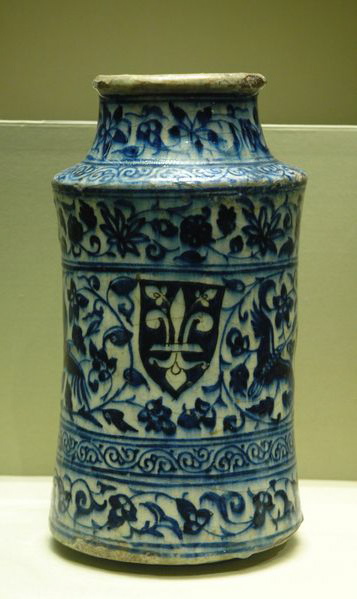fleurs trinitaires
This is a follow-up to an earlier post on trinity flowers. I've been looking out for threefold patterns in Islamic arts and crafts and I was especially intrigued by the Turkish panel shown below:

Velvet panel, Turkey 17th century. Museum of Fine Arts, Boston.
Not only does it have a pattern based on vaguely triangular shapes - similar to the French fleur-de-lys emblem - but it features an Escher-style repeating pattern in which the foregrounds and backgrounds "mirror" each other. I was moved to make a simple design derived from this panel, using the vector graphic program Inkscape:

fleur-de-lys trellis rendered in Inkscape
I went on to use this design as a decorative element at my article on The Forgotten Cup.
As I did further research on the fleur-de-lys emblem, I was led to the following further example of it within Islamic arts.

Albarello with fleur-de-lys decoration. Syria, 14th century.
Musée du Louvre, Paris. via wikimedia commons
Musée du Louvre, Paris. via wikimedia commons
From the wikipedia article on the fleur-de-lys, we learn that:
The use for ornamental or symbolic purposes of the stylised flower usually called fleur de lis is common to all eras and all civilizations. It is an essentially graphic theme found on Mesopotamian cylinders, Egyptian bas-reliefs, Mycenean potteries, Sassanid textiles, Gaulish coins, Mameluk coins, Indonesian clothes, Japanese emblems and Dogon totems. The many writers who have discussed the topic agree that it has little to do graphically with the lily, but disagree on whether it derives from the iris, the broom, the lotus or the furze, or whether it represents a trident, an arrowhead, a double axe, or even a dove or a pigeon. It is in our opinion a problem of little importance. The essential point is that it is a very stylised figure, probably a flower, that has been used as an ornament or an emblem by almost all civilizations of the old and new worlds.
Michel Pastoureau: Traité d'Héraldique, 2006.
This emblem, then, is quite ancient and can carry many meanings. It could be said to represent a natural threefold quality that expresses itself in many other ways but especially in the various triune deities. Islam repudiated such a triunity, not only in the Christian version (which Mohammad understood as God, Jesus and Mary) but in the pagan Arab version as the three goddesses Uzza, al-Manāt and al-Lāt.
Various esoteric meanings have been assigned to the number three (see this table of comparative numerology) but it is common to associate it with energy, movement, dynamism and change. By contrast, the number four stands for solidity, stability, conservatism and stasis. Both the numbers 7 (via addition) and 12 (via multiplication) are seen as syntheses of these opposites.
It seems to me that Islam, by consciously repressing triunity and three-ness, turned its back on change, on any idea of an evolving consciousness whether in the form of further advances in empirical knowledge or further clarifications through revelation.
And yet, such a powerful archetype, such an important aspect of deity, must have tried to "creep in" somehow and get a foot in the door of the two-way dialogue between Allah and Mohammad. It seems to me to be doing just that when those bizarre Arabic letters turn up at the start of Koranic chapters or suras. The first two suras (after the fatiha or opening) have three such letters: Alif Lam Mim. In all, three suras start with 1 letter, 10 with 2, 14 with 3, 2 with 4, and 2 with 5. It seems, then, that the theme of two (dialogue) is fairly strongly outweighed by the theme of three (in this case, a third party observer of the dialogue).
There is much talk about whether Islam can achieve some kind of renaissance or reformation that would render it better suited to the modern world. For Islam to change, I believe it must return to this issue of the triune nature of deity and come to a better understanding of this mystery. Reformers might look to those Islamic trinities like Rumi's water of life, the one who pours, and the one who drinks or Bayazid's wine-drinker, wine, and cupbearer or his even simpler (though more abstract) lover, beloved, and love. Perhaps the trinity flowers or today's fleurs trinitaires could be used as meditative tools, images for contemplation of how Islam might be transformed or understood in more modern and dynamic ways.
I can offer these flowers or fleurs but, as a non-Muslim or Kafir, I cannot take this any further. With God's grace, these flowers can shed seeds and take root in the good earth but it is up to a devout and modern Muslim to gather in whatever harvest emerges. In that task, he or she might take heed from the Word of God:
It is He who looses the winds, bearing good tidings before His mercy, till, when they are charged with heavy clouds, We drive it to a dead land and therewith send down water, and bring forth, therewith all the fruits. Even so We shall bring forth the dead; haply you will remember.
Koran 7:55 (7:57 in most editions), trans A.J. Arberry



0 Comments:
Post a Comment
<< Home